Tlaquepaque, Jalisco 作者: 来源: 发布时间:2021-07-22
1.Basic data
Pop.: 575,942 (aprox.)
Area: 270 km2
Elev.: 1,870 masl
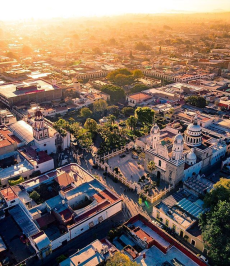
2. Natural geography
Tlaquepaque currently has a few forest areas where species of acacia, palo dulce and granjeno predominate. The native fauna is composed of rabbits, hares, squirrels, reptiles, and various bird species in the region.
The municipality has no river, has streams with the most outstanding being El Seco, Sebastianito and New Spain. Previously there were the dams Las Lomas, La Ladrillera, Las Pintas and Las Rusias. Most of the land has an urban use and the is held as private property.
Lithologically, the municipality was formed in the Quaternary period and is composed of pumitic tobas (commonly known as pumice stone that are made up of explosion products such as lapillis, puzolanas and ash. The predominant soils belong to the type haplic feozem and planosol eútric. An associated soil is the planepeloic sun.
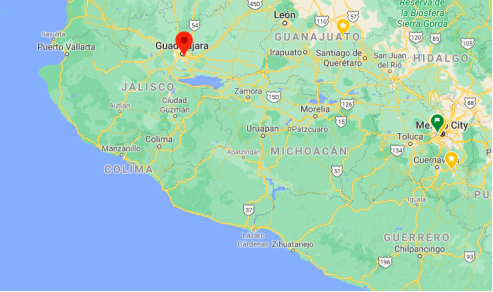
Weather
Köppen Classification: Humid Subtropical Climate
This climate is characterized by relatively high temperatures and evenly distributed precipitation throughout the year. This climate type is found on the eastern sides of the continents between 20° and 35° N and S latitude. In summer, these regions are largely under the influence of moist, maritime airflow from the western side of the subtropical anticyclonic cells over low-latitude ocean waters. Temperatures are high and can lead to warm, oppressive nights. Summers are usually somewhat wetter than winters, with much of the rainfall coming from convectional thunderstorm activity; tropical cyclones also enhance warm-season rainfall in some regions. The coldest month is usually quite mild, although frosts are not uncommon, and winter precipitation is derived primarily from frontal cyclones along the polar front.
The Köppen Climate Classification subtype for this climate is "Cfa". (Humid Subtropical Climate).
The average temperature for the year in Tlaquepaque is 69.8°F (21°C). The warmest month, on average, is May with an average temperature of 76.6°F (24.8°C). The coolest month on average is January, with an average temperature of 62.4°F (16.9°C).
The highest recorded temperature in Tlaquepaque is 106.2°F (41.2°C), which was recorded in May. The lowest recorded temperature in Tlaquepaque is 26.2°F (-3.2°C), which was recorded in February.
The average amount of precipitation for the year in Tlaquepaque is 38.0" (965.2 mm). The month with the most precipitation on average is July with 10.0" (254 mm) of precipitation. The month with the least precipitation on average is February with an average of 0.2" (5.1 mm). In terms of liquid precipitation, there are an average of 76.6 days of rain, with the most rain occurring in July with 18.2 days of rain, and the least rain occurring in March with 0.5 days of rain.
https://www.weatherbase.com/weather/weather-summary.php3?s=914132&cityname=Tlaquepaque%2C+Jalisco%2C+Mexico&units=
Getting there and around
The cheapest way to get from Mexico City to Guadalajara is to fly and bus which costs $650 - $1300 and takes 3h 31m. Also you can arrive to Guadalajara’s International Airport from outside of Mexico.
There are three options to get from Guadalajara City to Tlaquepaque:
·The cheapest way to get from Guadalajara to Tlaquepaque is to tram which costs $10 and takes 41 min.
·The quickest way to get from Guadalajara to Tlaquepaque is to taxi which costs $95 - $120 and takes 12 min.
·The driving distance between Guadalajara to Tlaquepaque is 13 km. It takes approximately 12 min to drive from Guadalajara to Tlaquepaque.
Guadalajara to Tlaquepaque Day Trip
Tlaquepaque is less than 10kms southeast of Guadalajara and can be visited independently or with a guided tour. If you’re short on time, this half-day tour covers the best of both worlds with an informative walking tour of Guadalajara’s historic sites as well as a visit to Tlaquepaque, Jalisco.
WITH UBER: We used Uber to travel from Guadalajara to Tlaquepaque and both the fare and travel time can vary quite a bit. We paid $100 pesos (April 2018) to get there and used Uber Pool on the way back for $75 pesos. It can take up to 40 minutes, depending on traffic and your starting point in the city.
BY TAXI: Tlaquepaque is a popular destination and taxis are readily available. Depending on your skills in Spanish and negotiating, you may be quoted double the Uber fare.
PUBLIC TRANSPORTATION: unfortunately Google doesn't populate routes for local transit around Guadalajara yet but the website Moovit does show local Guadalajara to Tlaquepaque buses.
TAPATÍO TOURS: Tapatío is a popular tour bus company in Guadalajara that has 4 different hop-on, hop-off routes. Tlaquepaque is Route #2, tickets start at $160 pesos per adult and buses depart from their office right by the Rotonda de los Jaliscienses Ilustres.
If you find yourself at Guadalajara's new bus station with time to spare, the heart of Tlaquepaque is only about 20 minutes away from the terminal (depending on traffic). You could easily store your things at the station, hop in an Uber/cab, walk along Independencia and be back within about 3 hours for your bus.
https://www.rome2rio.com/s/Mexico-City/Guadalajara
https://www.rome2rio.com/s/Guadalajara/Tlaquepaque
https://www.featherandthewind.com/blog/tlaquepaque-jalisco-guide
3. Economy
GDP: 1412M USD
4. Industry
The municipality of Tlaquepaque has 23,181 economic units in April 2019 and its distribution by sectors reveals a predominance of economic units dedicated to commerce, these being 47.39% of the total number of companies in the municipality. Tlaquepaque occupies position 3 at the regional and state level in terms of concentration of companies.
The three subsectors that add the most value are the beverage and tobacco industry; the food industry; and educational services, which together generated 33% of the total gross census added value registered in 2014 in the municipality.
Agriculture and livestock in Tlaquepaque
The value of agricultural production in Tlaquepaque has presented various fluctuations during the 2012-2017 period, having registered its highest level in 2016. The value of agricultural production in Tlaquepaque in 2014 represented only 0.4% of the total state agricultural production and had its maximum participation in 2013, contributing 0.6% of the state total in that year.
Livestock production in Tlaquepaque has grown during the 2012-2017 period, with 2017 being the year in which the highest growth in the value of livestock production has been recorded in the municipality. In 2017, the livestock production of Tlaquepaque represented 0.3% of the total state livestock production, this being the percentage of participation that it has maintained in recent years.
Artisan population in Tlaquepaque
According to the 2018 Artisan Census of the Jalisciense Institute of Crafts (IAJ), Tlaquepaque has 852 artisans, of which 476 or 56% are dedicated to pottery, and the rest to other types of crafts such as indigenous art, metalwork , textile, wood, among others. The artisans of Tlaquepaque represent 23.4% of the total number of artisans in the Central Zone of the entity with a total of 852 artisans and occupy the second place in the region. In the Central Zone, 34.7% are dedicated to pottery, 12.4% to indigenous art, 8.1% to metalwork, and the rest to other types of crafts.
https://iieg.gob.mx/ns/wp-content/uploads/2019/06/San-Pedro-Tlaquepaque.pdf
5. Touristic sites
Tlaquepaque (Tla-keh-pa-keh), a municipality of Guadalajara, has always enjoyed popularity not least due to its reputation as an important pottery town which makes and sells beautiful, hand-painted, distinctive artesanías. Given its proximity to Guadalajara, this quaint little municipality makes for the perfect day trip during your stay in the Jalisco capital.
Tlaquepaque is especially known for its galleries, ceramics, pottery and mariachi. It’s conveniently located less than 10 kms southeast of Guadalajara and frequently visited by locals and tourists alike with weekends being the busiest days.
The visitor's centre is a great place to start your day in Tlaquepaque. It's located by the colourful 'Tlaquepaque' sign on Calle Independencia (at Av. Niños Héroes). Here you can pick up a map and inquire about any special events or performances taking place on the day of your visit.
Tlaquepaque downtown
The center of Tlaquepaque is excellent for pedestrians and has some beautiful and colorful architecture. Enjoy the brightly painted buildings and the two imposing churches that can be found here: San Pedro and El Santuario de Nuestra Senora de la Soledad. Just strolling around the central streets of this municipality will really make you feel like you’re in traditional Mexico, a feeling that is often lost in the bigger cities such as Guadalajara and Mexico City. If you’re looking for a place to sit down and collect your thoughts, head to El Jardín Hidalgo and admire the larger-than-life statue of the eponymous Miguel Hidalgo y Costilla.
Art galleries
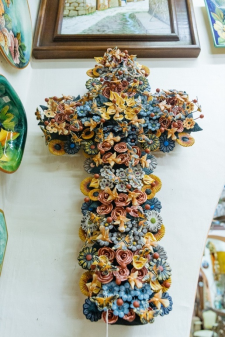
Tlaquepaque is replete with art, which is evident to
anyone who visits. Statues line the central avenues and art museums abound. Check out Pantaleón Panduro for ever-changing exhibitions which showcase local talent and the pottery for which this neighborhood is known. If pottery is what you’re after, then the Museo Regional de la Cerámica, situated in an old colonial house, is the obvious choice. We also recommend paying a visit to Galería Alejandro Calvillo if you want to snap up some one-of-a-kind and excellent works of art, including some by local artist Cesar Plascencia. Finally, the art gallery of Sergio Bustamente is unmissable; pick up some exquisite jewelry and wonder at his easily recognizable bronze statues.
Bars and nightlife
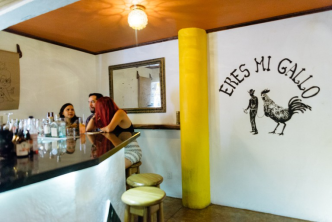
Tlaquepaque is as equally worth visiting in the evening as in the day time, with great night life and bar options to take advantage of. Either stay there into the evening before going out or pop back to your hotel and change. A taxi between Tlaquepaque and Guadalajara should set you back 100-150 pesos (between $6 and $9 US), so there’s no excuse not to make the journey. You can take your pick from any of the bars that line the Hidalgo or Juárez, as all are good options and usually have great drinks deals, but we recommend checking out TlaquePulque for their selection of affordable pulques and cheap beers, as well as an interesting Oaxacan-Japanese fusion menu.
Pottery and crafts
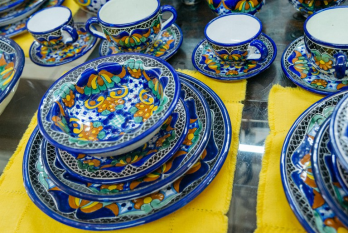
Artesanías are everywhere in Tlaquepaque and make excellent souvenirs to decorate your home or as Mexican gifts for friends and family. You cannot leave Tlaquepaque without having bought some of the pottery for which it is so known. A good place to start is the Mercado de Artesanías, which despite not offering the lowest prices, will allow you to get a feel for the type of souvenir you’re searching for. Afterwards, head further afield to make the purchases.
6. History and Culture
The name Tlaquepaque derives from Nahuatl and means "place above clay land". The area is famous for its pottery and blown glass. Before the Spaniards arrived on these lands, the Toluquilla, Zalatitán, Coyula, Tateposco, Tlaquepaque, Tapechi (Tepetitlán), and Tequepexpan, formed with Tonalá a kingdom, ruled by a woman named Cihualpilli Tzapotzinco. It was inhabited by Tonalteca Indians and later by the tecos that were in place at the arrival of the Spaniards. It was a pre-Hispanic town settled on a hill where they built houses of grass, reaching 500 inhabitants. In March 1530 he arrived in these lands Nuño de Guzmán and his people, entering San Martín de las Flores, formerly called Tlaxicoltzingo. Knowing the natives of the approach of the Spaniards, they were divided into two sides, because while Queen Cihualpilli and some gentlemen opted to give them a peaceful reception given their invincible power, others pretended to be resisted. The supporters of peace sent to the meeting of the Spaniards a delegation composed of nobles and rulers of the various peoples of the kingdom. From the town of Tlaquepaque were Coyotl, Chitacotl and Tonatl, Xonatic, Cuauhuntin and Oceotl, from the town of Tetlán, Coyopitzantli from Tzalatitán, Timoac and Oxatl, from Atemaxac, Ipac, from Ichcatlán, and Tzacamitl from Xocatic gift of chickens, eggs, honey, ahuacates, onions and some fruits to tell them that they already had news of their coming and that they were waiting for them amicably Guzmán well received by the Queen of Tonalá, being baptized with the name of Juana Bautista Danza. This name was the winner of a raffle that made names such as Petra, Micaela and Juana. Dance was chosen because it arranged a dance in honor of the Spaniards. Before entering the city, it sent several of its men to require the rebels who obtained in response a great shouting and a rain of arrows. Those who opposed confronted Guzman's army; The result of the meeting was unfavorable for the natives of the earth. All the rebels were captained by the lord of Tetlan, Tlaquitehuitli, and also by the Indian nobles Cuautipizahuac, and Catipamatac. On 25 March 1530, Nuño de Guzmán took possession of the kingdom of Tonalá and the subject peoples, including Tlaquepaque. In 1548, the town received the name of San Pedro, at the suggestion of Fray Antonio de Segovia, and during the colonial era and throughout the nineteenth century, he was only known by that name. From the second half of the sixteenth century it acquired the character of corregimiento subject to the jurisdiction of the city of Guadalajara. Once the Spaniards settled in Guadalajara, they began to exercise political and religious control in the surrounding towns, and the authorities of the incipient Pearl Tapatia ordered that San Pedro deliver a tribute according to the number of inhabitants and in accordance with their occupations. In that way, in 1551 they came and made the order clear to the encomendero that this tribute be fulfilled. San Pedro, according to the same census that was taken for the tax transaction, had 1416 inhabitants living in 177 jacales. The tribute they imposed was four loads of grass a day, ten chickens from Castile, ten loads of firewood and five service Indians a week, thirty blankets, forty tapatios, twenty pairs of quills, six loaves of salt and two jugs of honey, every two months, and four hundred hanegas of corn and twenty hanegas of chili every year. In the year 1600, San Pedro had fewer inhabitants than Toluquilla, which today belongs to Tlaquepaque.
By 1621, San Pedro was a doctrine of Franciscan religious from the convent of Guadalajara. On the morning of 26 November 1810, Hidalgo made his entrance to San Pedro where he was presented with a feast, and in the afternoon he entered the capital triumphantly.
The priest Miguel Hidalgo y Costilla arrives in San Pedro Tlaquepaque, on Sunday, 25 November, from Atequiza jal. It was arranged to take for your best comfort, the most comfortable house, you will be served a great banquet at noon, and at night a refreshment with all visitors, from the church and the government. Making preparations to leave San Pedro Tlaquepaque towards the capital today Guadalajara with around 7,000 men. Arriving around noon at the gates of the cathedral. In 1821, San Pedro Tlaquepaque was the cradle of the proclamation of the 'Independence of Jalisco' by the brigadier Pedro Celestino Negrete, since the document is signed in the town on 13 June of the same year . According to the decree of 27 March 1824, San Pedro became a member of the Guadalajara Department. In 1825, San Pedro is registered as a town.
7.Contact Information
City Mayor: María Elena Limón García

Contact number: +52 (33) 1057 6000
Govt. Office Address: Independencia #58 Colonia Centro, Tlaquepaque, Jal.
Twitter: https://twitter.com/MariaLimonG
Facebook: https://www.facebook.com/mariaelenalimon
Website: https://www.tlaquepaque.gob.mx/views/index.php
E-mail: mariaelena.limon@tlaquepaque.gob.mx
